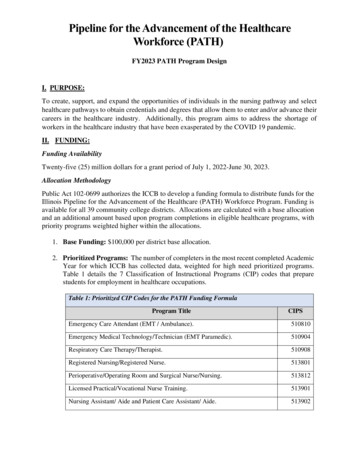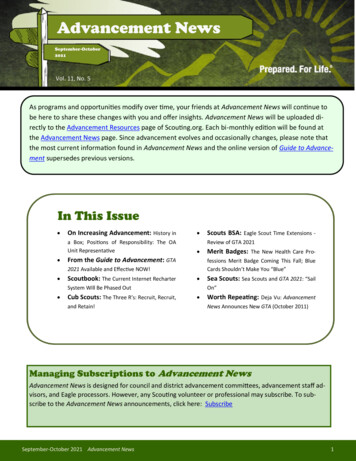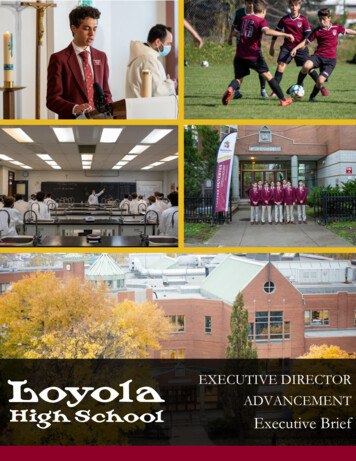
Transcription
Pipeline for the Advancement of the HealthcareWorkforce (PATH)FY2023 PATH Program DesignI. PURPOSE:To create, support, and expand the opportunities of individuals in the nursing pathway and selecthealthcare pathways to obtain credentials and degrees that allow them to enter and/or advance theircareers in the healthcare industry. Additionally, this program aims to address the shortage ofworkers in the healthcare industry that have been exasperated by the COVID 19 pandemic.II. FUNDING:Funding AvailabilityTwenty-five (25) million dollars for a grant period of July 1, 2022-June 30, 2023.Allocation MethodologyPublic Act 102-0699 authorizes the ICCB to develop a funding formula to distribute funds for theIllinois Pipeline for the Advancement of the Healthcare (PATH) Workforce Program. Funding isavailable for all 39 community college districts. Allocations are calculated with a base allocationand an additional amount based upon program completions in eligible healthcare programs, withpriority programs weighted higher within the allocations.1. Base Funding: 100,000 per district base allocation.2. Prioritized Programs: The number of completers in the most recent completed AcademicYear for which ICCB has collected data, weighted for high need prioritized programs.Table 1 details the 7 Classification of Instructional Programs (CIP) codes that preparestudents for employment in healthcare occupations.Table 1: Prioritized CIP Codes for the PATH Funding FormulaProgram TitleCIPSEmergency Care Attendant (EMT / Ambulance).510810Emergency Medical Technology/Technician (EMT Paramedic).510904Respiratory Care Therapy/Therapist.510908Registered Nursing/Registered Nurse.513801Perioperative/Operating Room and Surgical Nurse/Nursing.513812Licensed Practical/Vocational Nurse Training.513901Nursing Assistant/ Aide and Patient Care Assistant/ Aide.513902
Pipeline for the Advancement of the HealthcareWorkforce (PATH)3. Included Programs: Other programs that are in the healthcare pathway (see all othereligible programs in Table 3), in the most recent completed Academic Year for which ICCBhas collected data, weighted at approximately 2/3 the amount of funding per completion,compared to the prioritized programs.The funding formula for the PATH program was approved at the June 17, 2022 ICCB Boardmeeting.Allocations are published on the ICCB website: http://www2.iccb.org/iccb/grant-opportunities/ .Allowable and Unallowable CostsGrant recipients must adhere to the Grant Accountability Transparency Act (GATA) unlessotherwise permitted. Generally, colleges should consider capacity-building activities as well asbroad, wrap around services and supports for students as a key part of program development.TABLE 2: ALLOWABLE EXPENDITURE CATEGORY GUIDELINESCompensation—Personnel2 CFR 200.430Compensation for personnel services includes all remuneration, paid currently oraccrued, for services of employees rendered during the period of performance,including but not necessarily limited to wages and salaries.Compensation—Fringe Benefits2 CFR 200.431Fringe benefits are allowances and services provided by employers to theiremployees as compensation in addition to regular salaries and wages. Fringebenefits include, but are not limited to, the costs of leave (vacation, family-related,sick or military), employee insurance, pensions, and unemployment benefit plans.Except as provided elsewhere in these principles, the costs of fringe benefits areallowable provided that the benefits are reasonable and are required by law,employee agreement, or an established policy of the entity.Travel Costs2 CFR 200.474Travel costs are the expenses for transportation, lodging, subsistence, and relateditems incurred by employees who are in travel status on official business. Suchcosts may be charged on an actual cost basis, on a per diem or mileage basis in lieuof actual costs incurred, or on a combination of the two, provided the method usedis applied to an entire trip and not to selected days of the trip.Equipment2 CFR 200.33Equipment is defined as an article of tangible personal property that has a usefullife of more than one year and a per-unit acquisition cost which equals or exceedsthe lesser of the capitalization level established by the entity for financial statementpurposes, or 5,000. An applicant organization may classify equipment at a lowerdollar value but cannot classify it higher than 5,000. Please also see 2 CFR§200.439 Capital Expenditures.Supplies2 CFR 200.94All tangible personal property [other than those described in §200.33 Equipment].Generally, supplies include any materials that are expendable or consumed duringthe course of the grant.
Pipeline for the Advancement of the HealthcareWorkforce (PATH)Contractual Services2 CFR 200.318All products or services which are procured by contract. “Contract” means a legalinstrument by which an entity purchases property or services needed to carry outthe project or program.Training andEducation2 CFR 200.472The cost of training and education provided for employee development.Indirect CostOther ExpendituresIII.In order to charge indirect costs to a grant, the applicant organization must have anannually negotiated indirect cost rate agreement (NICRA). There are three types ofNICRA’s. Federally Negotiated Rate. Organizations that receive direct federalfunding may have an indirect cost rate that was negotiated with theFederal Cognizant Agency. ICCB will accept the federally negotiatedrate. State Negotiated Rate. The organization must negotiate an indirect costrate with the State of Illinois if they do not have a Federally NegotiatedRate or elect to use the De Minimis Rate. The indirect cost rate proposalmust be submitted to the State of Illinois within 90 days of the noticeof award. De Minimis Rate. An organization that has never received a FederallyNegotiated Rate may elect a De Minimis rate of 10 percent of modifiedtotal direct cost (MTDC). Once established, the De Minimis rate maybe used indefinitely. The State of Illinois must verify the calculation ofthe MTDS annually in order to accept the De Minimis rate.Must first be approved in writing by appropriate ICCB staff. Please include a shortdescription of any costs listed under this Budget Category.PROGRAM DESCRIPTION:All programs developed or supported through this initiative should be a part of a career pathwaythat allows participants to obtain an industry-recognized credential and/or a community collegecertificate in the shortest possible time while maintaining quality instruction and enhancing theparticipant’s eligibility for employment in the healthcare sector (particularly CNA, LPN, RN).Eligible programs to be supported are included below. Programs may be credit or non-credit.Target PopulationThis initiative aims to meet unmet healthcare community and employment needs by increasingenrollment and retention in nursing and other healthcare pathways, specifically forunderrepresented groups of students who might not otherwise be successful or able to enroll inhealthcare programs. The project would focus on three populations:1) Incumbent workers who are already in the workforce looking to continue their education andadvance their careers in the nursing or healthcare pathway in Illinois.2) New, entering students on a nursing or healthcare pathway with an identified need forsupport.
Pipeline for the Advancement of the HealthcareWorkforce (PATH)3) Low-income, first generation, and minority students as a subset of both of theaforementioned target population categories.PATH-Eligible ProgramsTable 3 lists the programs (credit and/or non-credit) that can be supported by PATH funding. TheTable provides the program name, associated CIP, and whether the program is a “priority” programfor allocation purposes. Colleges will be required to specifically address all non-creditprograms proposed for funding, in their implementation plans.Table 3: PATH-Eligible ProgramsProgramHealth Services/Allied Health/ Health Sciences, General.Hospital and Health Care Facilities Administration/Management.Health Unit Coordinator/Ward Clerk.Medical Office Management/ Administration.Health Information/Medical Records Administration/Administrator.Health Information/Medical Records Technology/Technician.Medical Transcription/ Transcriptionist.Medical Office Assistant/Specialist.Medical Reception/Receptionist.Medical Insurance Coding Specialist/Coder.Medical Insurance Specialist/Medical Biller.Medical Administrative/Executive Assistant and MedicalSecretary.Medical Staff Services Technology/Technician.Medical/Clinical Assistant.Clinical/Medical Laboratory Assistant.Occupational Therapist Assistant.Pharmacy Technician/Assistant.Physical Therapy Assistant.Anesthesiologist Assistant.Emergency Care Attendant (EMT \Ambulance).Allied Health and Medical Assisting Services, Other.Cardiovascular Technology/Technologist.Electrocardiograph y Medical Technology/Technician (EMTParamedic).Nuclear Medical Technology/Technologist.Medical Radiologic Technology/Science - RadiationTherapist.Respiratory Care Therapy/Therapist.Surgical 09PATH ludedIncludedIncluded; WeightedIncludedIncludedIncludedIncludedIncluded; WeightedIncludedIncludedIncluded; WeightedIncluded
Pipeline for the Advancement of the HealthcareWorkforce (PATH)Diagnostic Medical Sonography/Sonographer and UltrasoundTechnician.Radiologic Technology/Science - Radiographer.Polysomnography.Mammography Technology/Technician.Magnetic Resonance Imaging (MRI) Technology/Technician.Clinical/Medical Laboratory Technician.Histologic Technician.Phlebotomy Technician/Phlebotomist.Sterile Processing Technology/Technician.Substance Abuse/Addiction Counseling.Psychiatric/Mental Health Services Technician.Community Health Services/Liaison/ Counseling.Mental Health Counseling/Counselor.Mental and Social Health Services and Allied Professions,Other.Health Aide.Home Health Aide/Home Attendant.Registered Nursing/Registered Nurse.Perioperative/Operating Room and Surgical Nurse/Nursing.Licensed Practical/Vocational Nurse Training.Nursing Assistant/ Aide and Patient Care Assistant/ dedIncluded; WeightedIncluded; WeightedIncluded; WeightedIncluded; WeightedProgram StrategiesThis program models the Workforce Equity Initiative, a statewide grant program focused onexpanding short-term training opportunities for minority students in underinvested communities byproviding comprehensive wraparound support and career services. For this program, the targetpopulations are expanded to include low-income students, first-generation students, and entry-levelincumbent workers. Also supported in WEI, the PATH program adopts the use of career pathwaysas an overarching strategy to address pain points in the healthcare talent pipeline as well as issuesof equity within preparation and employment. Strategies and allowable uses of funds arepurposefully broad and flexible to allow for innovation and discretion by each college. Both creditand non-credit programs, as identified by the Approved CIP list (Table 3), can be supportedthrough this initiative. Colleges should tailor strategies to the needs of their local community andemployers.Potential and impactful strategies include: Recruitment and Outreach – expanding current recruitment and outreach efforts, buildingcommunity rapport, hiring program recruiters, collaborative partnerships to access newtalent pools and additional program on-rampsAccelerated Learning Strategies – developing, implementing, and expanding dual creditpathways, bridge programming, integrated education and training, competency-basededucation programs, stackable credentialing, creating smooth transitions between noncredit and credit, improving the use of PLA
Pipeline for the Advancement of the HealthcareWorkforce (PATH) Capacity-Building Activities – developing or expanding program/section offerings,mitigating clinical availability, hiring additional staff and instructors, staff retention efforts,professional development for faculty and staff, purchasing/upgrading equipment, expandinglab capacityWork-Based Learning – developing and offering internship, pre-apprenticeship,apprenticeship and opportunitiesWraparound Support Services – offering academic and non-academic supports- tutoring,childcare, financial support through stipends and last dollar tuition assistance,transportation, transition services for individuals with disabilities, etc.Partnerships and Collaboration- With universities to deliver the BSN, with CBOs todeliver support services or build on-ramps, with employers, coordination and referrals withthe local One Stop CenterCustomized Training - Incumbent worker training or customized training, intentionalintegration of essential employability skills training, modularized training programs, skillsremediation and course preparationIV. PERFORMANCE AND REPORTING:Program Metric: Number of CompletionsTo assess the extent to which the program is successful in preparing more individuals foremployment in the healthcare field, districts will be held to a performance target for completions.Data will be disaggregated by race, ethnicity, gender, whether a student is a new entrant orincumbent worker, and income (Pell status) for the purposes of identifying opportunities to addressequity gaps.Completion is defined as a student who completes a PATH-eligible program within the AcademicYear, culminating in a credential. This is a duplicated count, for example, meaning that if a studentcompletes a 16-week program in the fall semester and then transitions into another eligible programin the spring semester and completes, the student would be counted for two completions. The ICCBhas set completion targets for each district based on the most recent academic year’s completions,representing an approximate growth of 15%. ICCB will communicate these targets to eachindividual district.Other data including enrollment, retention, and percentage of students employed post-completionwill be captured to measure the success of the grant program or identify opportunities forimprovement. While most of these data will be collected through regular ICCB MIS submissions,data via quarterly reporting or other supplemental reports may be requested throughout the fiscalyear. Enrollment is defined as number of full-time and part-time students enrolled in eligiblePATH programs.
Pipeline for the Advancement of the HealthcareWorkforce (PATH) Full-time Retention is defined as new (i.e., first-time), full-time certificate/degree studentsin the Fall (denominator) that are retained the following Fall (numerator). Also included inthe numerator are students that graduated during the academic year of enrollment. A varietyof community college certificate programs can be completed in an academic year and, thus,there is not a need to re-enroll the following Fall.Part-time Retention is defined as new (i.e., first-time), part-time certificate/degree studentsin the Fall (denominator) that are retained the following Fall (numerator). Also included inthe numerator are students that graduated during the academic year of enrollment.Student Employed will be captured through a data match with IDES.Other DeliverablesDistricts will carry out activities as described in their approved Implementation Plan to meet thegoals of the PATH program. In addition to program-specific activities, districts will be required toparticipate in grant meetings, professional development, and technical assistance as designed by theICCB and its partners.ReportingInstitutions will be required to report on the identified data points above via three mechanisms: Quarterly programmatic and financial reports as required by the ICCB toiccb.grantpayments@illinois.gov.Annual submissions through the regular ICCB MIS submissions, including any supplemental(and more current) attachments specific to the funded Healthcare Pathway Projects.Any additional supplemental reports as required by the ICCB.FY2023 Reporting Schedule for the PATH ProgramQuarterPeriodDate Due1July 1 – September 30, 2022October 30, 20222October 1 – December 31, 2022January 30, 20233January 1 – March 31, 2023April 30, 20234April 1 – June 30, 2023July 30, 2023V. IMPLEMENTATION PLANNINGIn order to receive funding under the PATH Program, districts must complete and submit anImplementation Plan, along with supporting documents. Document templates can be found on the
Pipeline for the Advancement of theHealthcare Workforce (PATH)ICCB website: Grant Opportunities and Information – Illinois Community College Board(iccb.org).Summary of documents to be submitted to ICCB.1.2.Implementation Plan – template providedUniform Budget – template providedVI. Agency Contact(s)Project Lead:Whitney ThompsonDeputy Director for Workforce pson@illinois.gov217.558.0318Project Manager:TBD
Technician. 510910 Included Radiologic Technology/Science - Radiographer. 510911 Included Polysomnography. 510917 Included Mammography Technology/Technician. 510919 Included Magnetic Resonance Imaging (MRI) Technology/Technician. 510920 Included Clinical/Medical Laboratory Technician. 511004 Included Histologic Technician. 511008 Included











